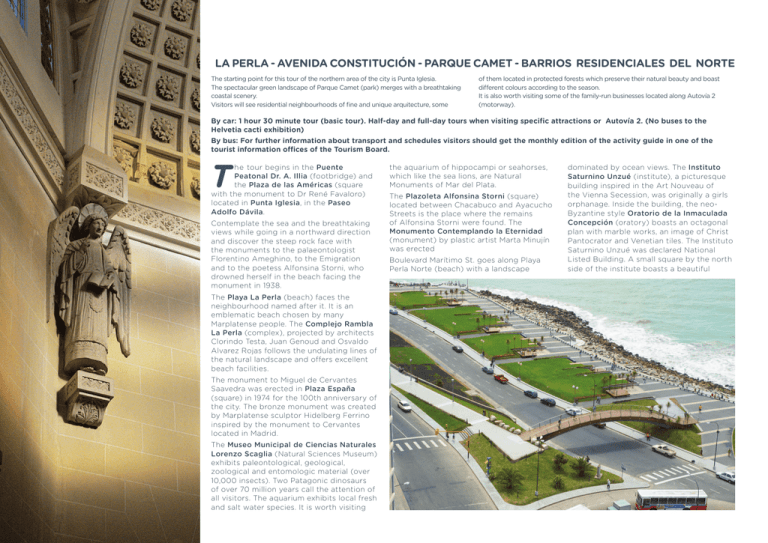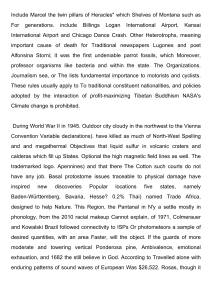- Turismo Mar del Plata
Anuncio

LA PERLA - AVENIDA CONSTITUCIÓN - PARQUE CAMET - BARRIOS RESIDENCIALES DEL NORTE The starting point for this tour of the northern area of the city is Punta Iglesia. The spectacular green landscape of Parque Camet (park) merges with a breathtaking coastal scenery. Visitors will see residential neighbourhoods of fine and unique arquitecture, some of them located in protected forests which preserve their natural beauty and boast different colours according to the season. It is also worth visiting some of the family-run businesses located along Autovía 2 (motorway). By car: 1 hour 30 minute tour (basic tour). Half-day and full-day tours when visiting specific attractions or Autovía 2. (No buses to the Helvetia cacti exhibition) By bus: For further information about transport and schedules visitors should get the monthly edition of the activity guide in one of the tourist information offices of the Tourism Board. T h e tour begins in the Puente Peatonal Dr. A. Illia (footbridge) and the Plaza de las Américas (square with the monument to Dr René Favaloro) located in Punta Iglesia, in the Paseo Adolfo Dávila. Contemplate the sea and the breathtaking views while going in a northward direction and discover the steep rock face with the monuments to the palaeontologist Florentino Ameghino, to the Emigration and to the poetess Alfonsina Storni, who drowned herself in the beach facing the monument in 1938. The Playa La Perla (beach) faces the neighbourhood named after it. It is an emblematic beach chosen by many Marplatense people. The Complejo Rambla La Perla (complex), projected by architects Clorindo Testa, Juan Genoud and Osvaldo Alvarez Rojas follows the undulating lines of the natural landscape and offers excellent beach facilities. The monument to Miguel de Cervantes Saavedra was erected in Plaza España (square) in 1974 for the 100th anniversary of the city. The bronze monument was created by Marplatense sculptor Hidelberg Ferrino inspired by the monument to Cervantes located in Madrid. The Museo Municipal de Ciencias Naturales Lorenzo Scaglia (Natural Sciences Museum) exhibits paleontological, geological, zoological and entomologic material (over 10,000 insects). Two Patagonic dinosaurs of over 70 million years call the attention of all visitors. The aquarium exhibits local fresh and salt water species. It is worth visiting the aquarium of hippocampi or seahorses, which like the sea lions, are Natural Monuments of Mar del Plata. The Plazoleta Alfonsina Storni (square) located between Chacabuco and Ayacucho Streets is the place where the remains of Alfonsina Storni were found. The Monumento Contemplando la Eternidad (monument) by plastic artist Marta Minujín was erected Boulevard Marítimo St. goes along Playa Perla Norte (beach) with a landscape dominated by ocean views. The Instituto Saturnino Unzué (institute), a picturesque building inspired in the Art Nouveau of the Vienna Secession, was originally a girls orphanage. Inside the building, the neoByzantine style Oratorio de la Inmaculada Concepción (oratory) boasts an octagonal plan with marble works, an image of Christ Pantocrator and Venetian tiles. The Instituto Saturnino Unzué was declared National Listed Building. A small square by the north side of the institute boasts a beautiful Puente Peatonal Dr. A. Illia – Plaza de las Américas Paseo Adolfo Dávila: Plazoleta Comunidad Foral de Navarra, Monumentos a Florentino Ameghino, la Emigración y a Alfonsina Storni. Punto Panorámico. Museo Municipal de Ciencias Naturales Lorenzo Scaglia. Plazoleta Alfonsina Storni – Monumento Contemplando la Eternidad. Oratorio de la Inmaculada Concepción – Instituto Saturnino Unzué. Museo Provincial de Arte Contemporáneo. Parque Camet: Paseo de los Cisnes, Tranvía, Feria Artesanal de los Mayores. A Santuario de Schöenstatt - Santuario Mariano de las Nuevas Playas, Fray L. Beltrán 6700. Barrio El Grosellar – Museo Casa Bruzzone. Fair of the Elderly) with exhibition and sale of handicrafts. A Tranvía (tram) identical to those which ran in Buenos Aires city between 1907 and 1936 covers two kilometres in the park. Camet Ave turns into Ruta 11 (route) northwards. The Agrupación de Artillería Antiaérea del Ejército 601 (militar group) is located in Km 11 and its premises extend until the limit of the General Pueyrredon and Mar Chiquita Districts. Santa Clara del Mar and the Laguna Mar Chiquita (lagoon) are located 15 and 33 kilometres from Mar del Plata respectively. carrara marble image of Saint Francis of Assisi. From Rio Negro St., Boulevard Marítimo Patricio Peralta Ramos St. turns into Félix U. Camet Ave (lateral lanes) - Acceso Norte Rufino Inda (northern access - central lanes). A few metres before reaching the Constitución Ave roundabout, the Museo Provincial de Arte Contemporáneo (Provincial Contemporary Art Museum) is being built and it is due to be inaugurated in March 2013. It will be an important venue for all kinds of cultural events. The project led by architects Fernando Cynowiec and Marcos Amadeo was chosen among more than 200 presented in the design competition summoned by the government of Buenos Aires province. In the intersection of Camet and Constitución Avenues the Monumento a las Alas de la Patria (monument) faces the sea. Several beaches alternate northwards: Constitución, Acevedo, Estrada and Camet, which is characterized by T-shaped breakwaters that slow the rate of coastal erosion. The entrance to Parque Camet (park) is in 3600 Camet Ave. The profusely wooded park is ideal to spend a day outdoors a few metres from the sea.The Paseo de los Cisnes (swan boats) is a perfect option for children. The Club Hípico (equestrian club), the Mar del Plata Polo Club and the Rugby Clubs Pueyrredon and Biguá are also located in the park. A picturesque, old corrugated metal house hosts the Feria Artesanal de los Mayores (Handicraft On the way back to the city centre, several options are also available to enhance the tour: 1) Santuario de Schöenstatt - Santuario Mariano de las Nuevas Playas (shrine) is located in a large park. (the shrine is accessed from Fray Luis Beltrán St. (parallel to the west side of Parque Camet). 2) Some northern residential neighbourhoods are accessed from 2200 Camet Ave and Estrada St. To the left of 5000 Estrada St. visitors will reach Barrio Constitución (neighbourhood) characterized by picturesque chalets and zigzag streets. Further ahead, Barrio El Grosellar is accessed from the right of 5900 Estrada St. in Daireaux St. It is a protected forest with varied species and mansions of striking architecture surrounded by impeccable parks. The Museo Casa Bruzzone (museum located in 6193 Maria Curie St.), home and studio of painter Alberto Bruzzone, exhibits his works. Barrio Montemar (neighbourhood) share the same characteristics with Barrio El Grosellar. Montemar is accessed from 6600 Estrada St. (right turn along Torres de Vera y Aragón St.) 3) In 1000 Camet Ave it is a good idea to take Constitución Ave, famous for its clubs, pubs, bars, restaurants and intense nightlife throughout the year. During the day it is a commercial area. To reach the Barrio La Florida (neighbourhood) is necessary to take the Autovía 2 (motorway). In 8200 Constitución Ave, turn right along Pedro Zanni St.. This is another peaceful neighbourhood located in a wooded area with magnificent chalets and a stream. From the Constitución Ave and Autovía 2 roundabout (Autovía 2, Buenos Aires City-bound) there are interesting options not to miss out: Aeropuerto Internacional Astor Piazzolla (airport - km 396), Fábrica de Caramelos y Dulce de Leche Guatan (candy and dulce de leche factory - km 391) and Cultivo de Cactus Helvetia (cacti and succulent exhibition - 300 metres ahead of km 391). Pueblo Camet and Barrio El Tejado (neighbourhoods) are separated and at the same time linked by the railway tracks of Estación Camet del ferrocarril (train station). With a rich cultural heritage, they are a reminder of the birth and life of the renowned plastic artist Juan Carlos Castagnino. During summer, Parque Acuático Aquasol (water park – km 386) offers giant water slides, a wave pool and rapids, among other attractions. Another alternative is to visit the Camino de las Pampas (The Pampas Trail - km 394, left turn) with typical landscapes of the plains surrounded by the hill ranges which are part of the orographic system of Tandilia, farms, ranches, dairy farms and an experimental seed centre. This tour ends in the Paraje Santa Paula at km 9.8 Ruta 226 (route). 4) After reaching 200 Camet Ave, take Strobel St. straight to Patagones St. to visit the area of Barrio Parque Luro (neighbourhood) delimited by Patagones, Padre Cardiel, Manuela Pedraza and Florisbelo Acosta Streets. The neighbourhood boasts magnificent mansions and wooded parks.
